(A true story; the names of the woman and the company are changed).
Ana is the PMO director at Compagil and this year she is leading a strategic initiative.
In the recent years the company has carried out different initiatives – some business areas have piloted Agile practices, others Kanban. The usage of OKR has been studied at the strategic level. The COO is advocating for using Lean in order to improve process efficiency and reduce costs. The Talent and Culture area is focused on introducing a culture of collaboration, transparency and customer orientation.
Despite all the pilots running in parallel, project management is still done and reported in the classic manner.
The people responsible for each initiative have their ideas and proposals of what management practices have to be introduced in the company. However, the conversations between them are not very fruitful, one has the feeling that they speak in different languages.
So, Ana’s goal is to harmonize the use of all the methods and terminologies and define the company’s standard project management process and its tailoring guidelines according to the different project characteristics and circumstances that occur in their execution.
“Defining a common language that accommodates the ideas and concepts of all these different methods in the company’s vocabulary, is a difficult task in itself. However, the metrics issue is even more complicated.” told me Ana.
“All the methods bring their metrics and in Compagil we use others historically. I do not understand the relationships between Agile metrics, Kanban, KPIs and OKRs. It is impossible and counterproductive to measure everything and track every aspect that the methods suggest. So, what do we really have to measure and without losing control over our projects?” continued Ana.
More and more often I have this same conversation. Therefore, I thought that responding to these doubts in a post could help you too. Of course, if you are in a situation similar to Ana’s, you should bring together your colleagues who are involved in the different initiatives, and, together, develop the appropriate solution for your company.
OKRs, metrics, KPIs – what is it and how to use them?
Each company is unique. Therefore, I am going to concentrate on the main concepts and how to use them in the development of your solution.
1. Define Objectives and Key Results (OKRs)
Essentially, an initiative of this type should resolve real organization’s problems to be useful.
Therefore, start by identifying the main pain points.
Based on these, define the organization’s objectives for the year, the next quarter or another relatively short period of time.
Then, define what results would demonstrate progress or achievement of each one of the objectives. Think about tangible and measurable results, not just actions.
An example of objectives and key results is illustrated in the following image:
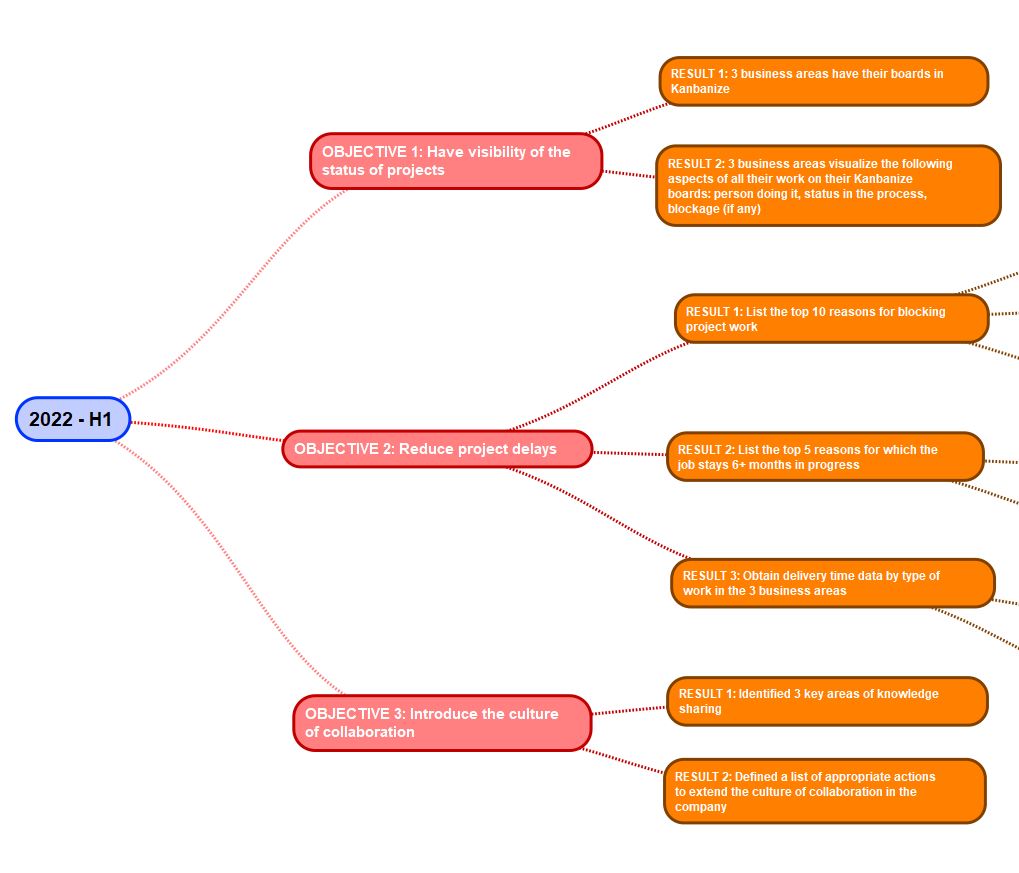
- OBJECTIVE 1: Have visibility of the project status
- Result 1: 3 business areas have their boards in Kanbanize
- Result 2: 3 business areas visualize the following aspects of all their work on their Kanbanize boards: person doing it, status in the process, blockage (if any)
- OBJECTIVE 2: Reduce project delays
- Result 1: List the top 10 reasons for blocking project work
- Result 2: List the top 5 reasons for which the job stays 6+ months in progress
- Result 3: Obtain delivery time data by type of work in the 3 business areas
- OBJECTIVE 3: Introduce the culture of collaboration
- Result 1: Identified 3 key areas of knowledge sharing
- Result 2: Defined a list of appropriate actions to extend the culture of collaboration in the company
Use the complete image of your objectives and key results to agree what to focus the attention of your organization on. Make sure that you all have the same understanding of your objectives and results to be achieved and that these are aligned with the strategic direction of your company.
2. Define actions and metrics
The next step is define the appropriate actions to achieve the results. Following our example, these could be:
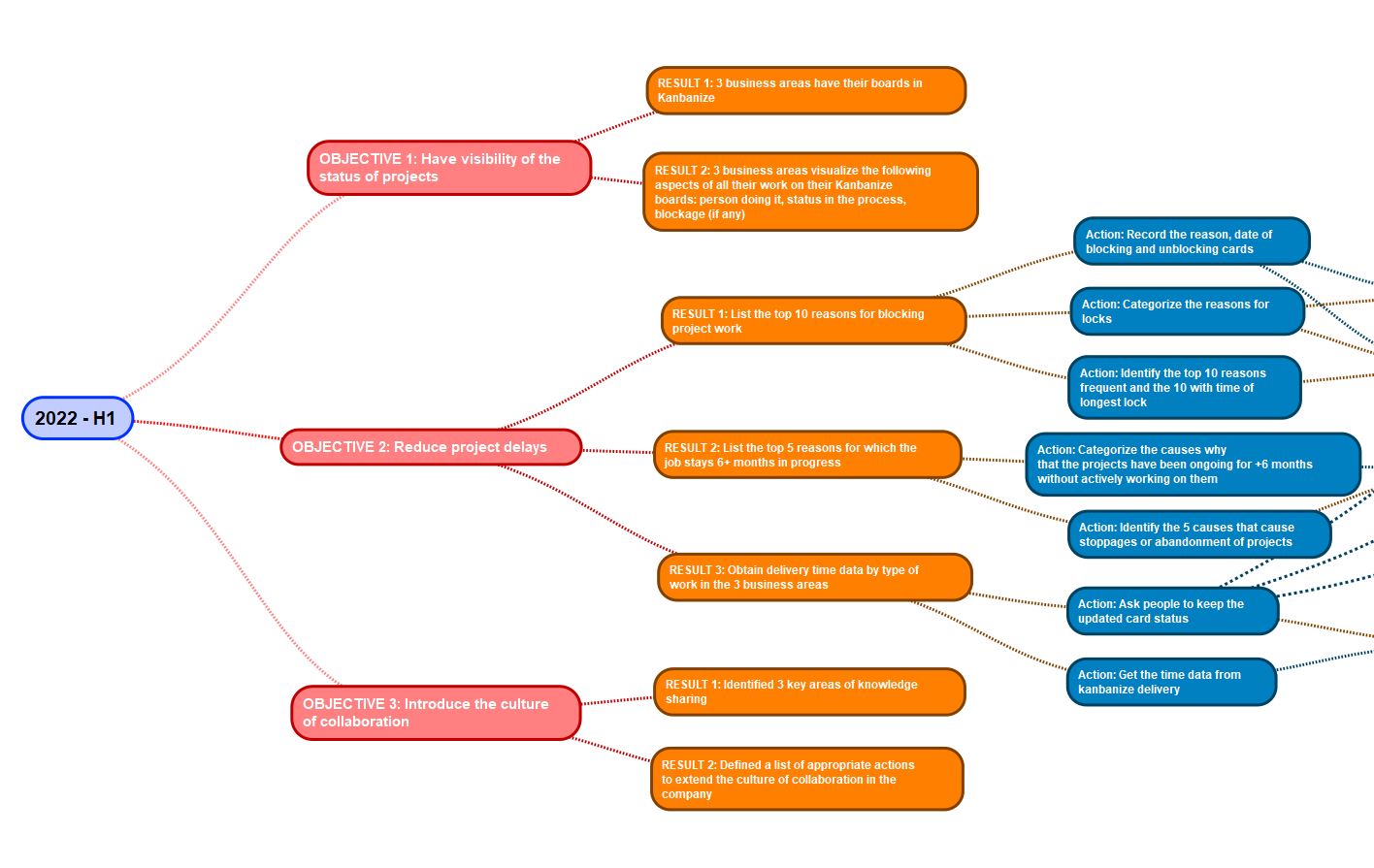
And now we come to the question “what metrics related to the actions allow you to demonstrate / evidence the results?”.
For example, to get the top 10 causes of workflow stops, we need to get the list of the causes for the blockages, as well as the time the work items stayed blocked due to them.
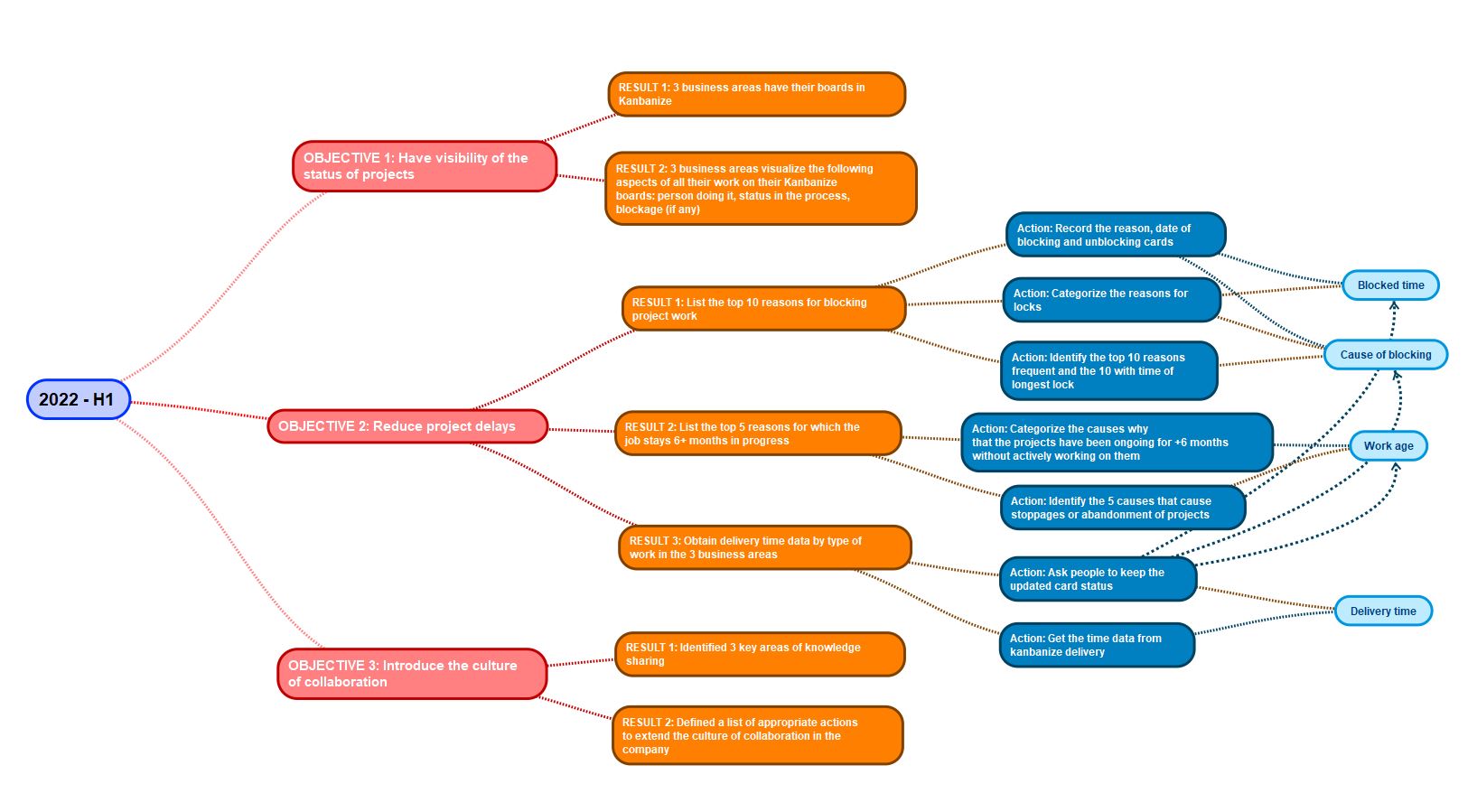
Stay focused. If your tree gets too branchy, focus on the 3-5 most important objectives and 2-4 results/outcomes per objective. You can address the other aspects In the next improvement cycle.
You see the relationships between OKR and Metrics, do not you?
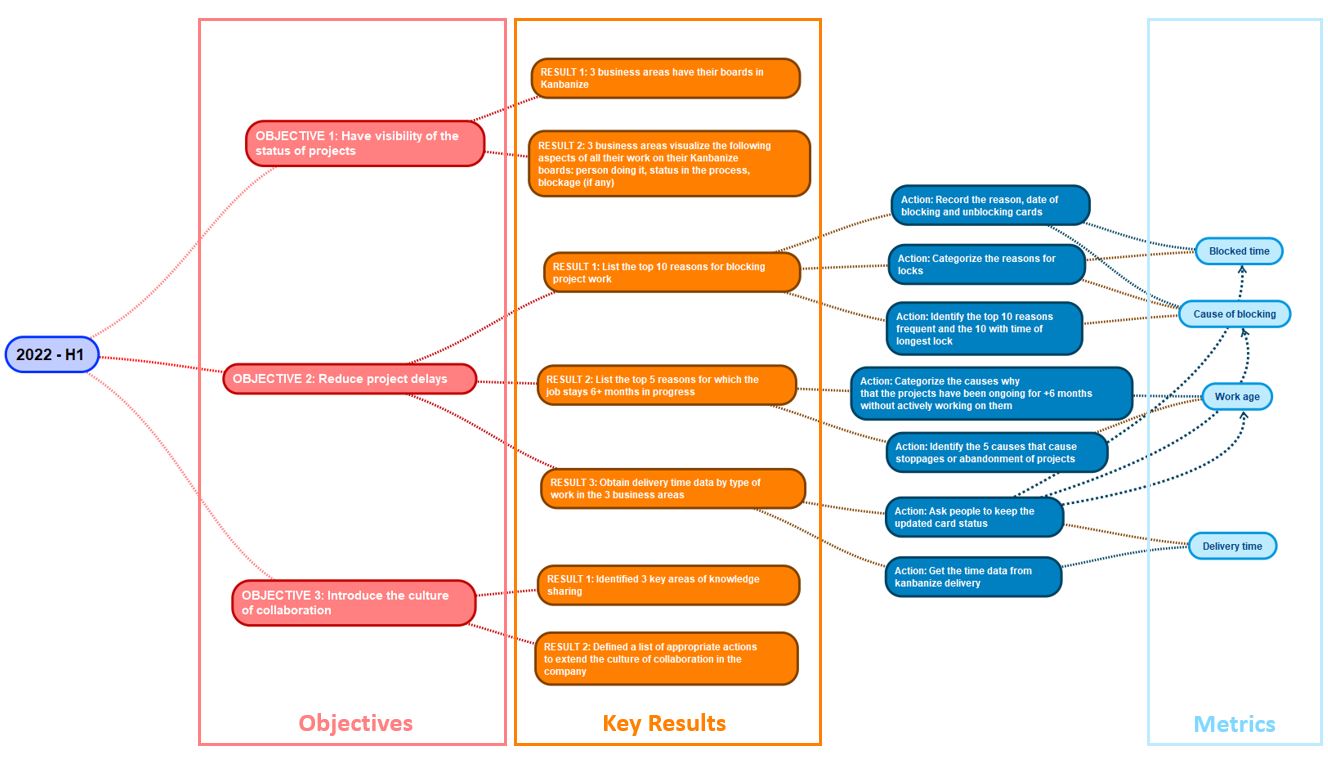
3. Define KPIs
KPIs (Key Performance Indicators) measure the completion of business goals. Therefore, they are called Key. KPIs indicate whether the business is healthy and developing well.
Typically, these indicators are related to the following:
- Meeting customer expectations
- Time to market; product and service delivery time, as well as customer delivery time
- Efficiency of key organizational processes
- Product and service quality
- Employee satisfaction
Both, improvement objectives (related to pain points) and KPIs can be defined for each level of the organization.
If any of your improvement objectives is related to a business goal and, therefore, to a KPI, mark it to make it explicit for the entire organization.
For example, let us assume that Objective 2: Reduce delays is related to the business goal Reduce time-to-market. Then, the indicator for project delays is KPI. Therefore, the Lead Time and Blocked Time metrics that are associated with this KPI and are key as well.
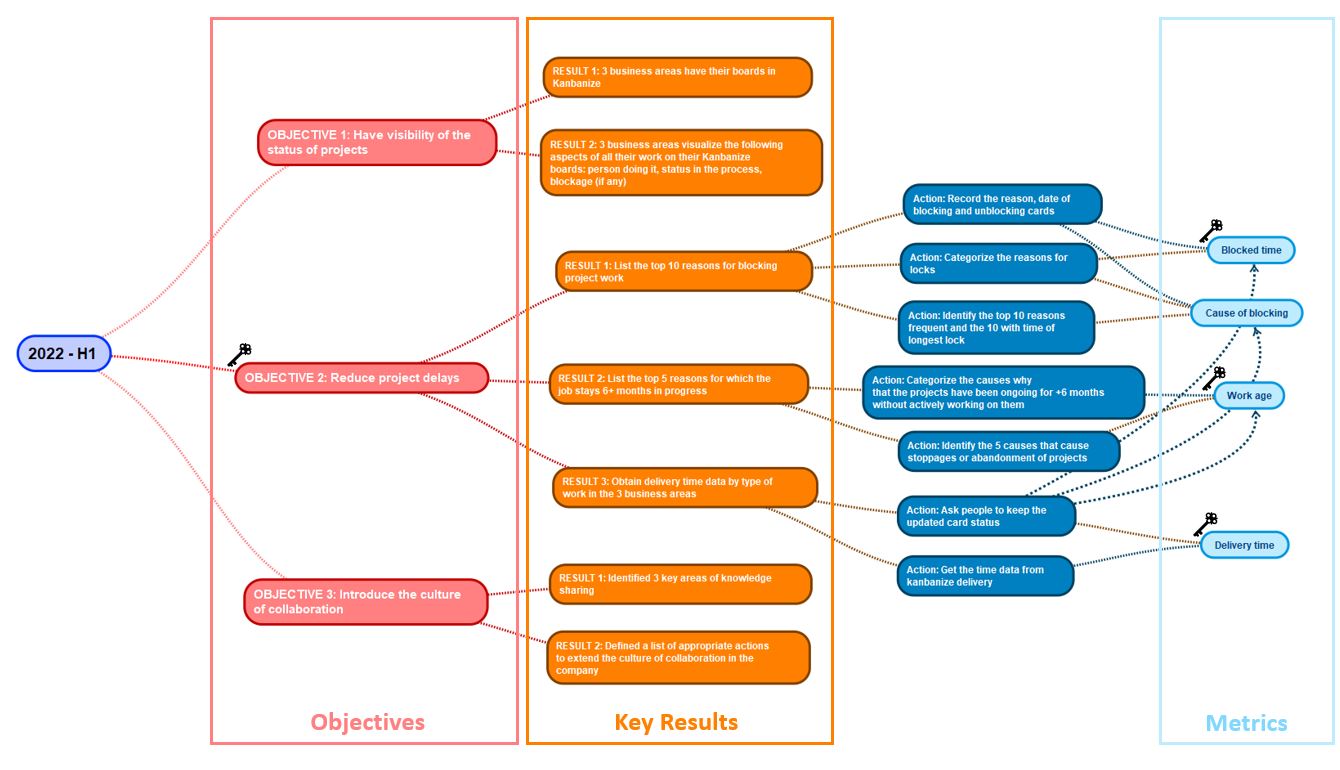
Now you have the complete map that you can use to agree and focus the attention of the entire organization on what is important to you.
Conclusion
To wrap up, the improvement objectives are related to current pain points, a specific need of the organization, or a business objective. The results demonstrate the progress towards the objectives. Achieving them requires taking some actions. The metrics allow monitoring and making the right decisions to achieve the objectives. KPIs are indicators and metrics that are related to the achievement of key business goals.
It is important to understand how to define the complete system of objectives – results – actions – metrics. It is even more important to use them effectively to achieve improvements for the organization. Therefore, concentrate on the few objectives and vital results that are important for your company.
Visualizing the relationships between goals, results, actions, and metrics allows you to communicate and align around these goals.
Teodora Bozheva
Accredited Kanban Trainer & Consultant
Co-autora del Kanban Maturity Model
www.berriprocess.com
Related posts:


